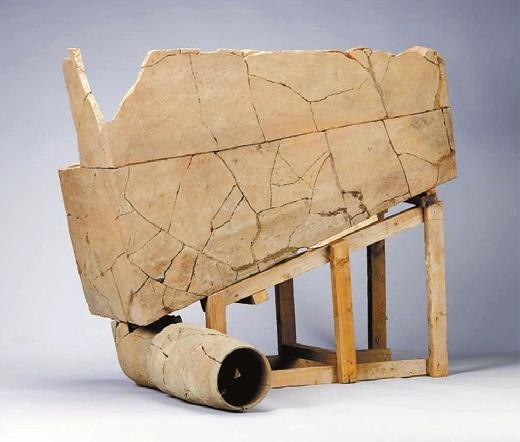
A POTTERY flush toilet, dating back 2,400 years, has piqued the interest of archaeologists who are trying to find out what people ate during that time by analyzing soil samples collected from it. The ancient relic consists of two parts, an indoor toilet on a platform and a pipe system below that directed sewage outside. Broken parts of the toilet, including a bent pipe, were unearthed from the Yueyang archaeological site in Xi’an, Shaanxi Province, last summer and pieced together for months before researchers released details last week. Discovered amid the ruins of a palace in the ancient Yueyang City, the toilet is believed to have been used by Qin Xiaogong or his father Qin Xian’gong of the Qin State during the Warring States Period (476-221 B.C.), or by Liu Bang, the first emperor of the Han Dynasty (202 B.C.-A.D. 220). The palace was possibly used for administrative affairs. Fan Mingyang, a design expert specializing in ancient agricultural tools, said the toilet looks “deceptively advanced” as it seems to have had a flush water drainage system akin to modern toilets. A luxury object such as a flush toilet would only be used by very high-ranking members of the society during that time, according to Liu Rui, a researcher at the Institute of Archaeology at the Chinese Academy of Social Sciences, who was part of the excavation team. “It is the first and only flush toilet to be ever unearthed in China,” he said. The toilet bowl was placed indoors, with the pipe leading to an outdoor pit, he said, adding that servants probably poured water into the toilet every time it was used. Liu said the upper half of the flush toilet was not found during the excavation and hence, experts cannot confirm whether its users sat on it or squatted over it. However, based on previous records about toilets, such as stone carvings on the tombs of royal members during the Western Han Dynasty (202 B.C.-A.D. 8), they likely squatted over it. Experts are analyzing the soil inside, hoping to find traces of human feces and learn about the eating habits of ancient people. So far, the soil samples have only yielded traces of fertilizers used by farmers in the Han Dynasty Before this toilet was unearthed, the first manual flush toilet was believed to have been invented by John Harington for Queen Elizabeth I in the 16th century. Yueyang was the capital of the Qin State for about 35 years and also the first capital of the Han Dynasty, during which palaces were demolished to make way for farmlands. Since 2012, archaeologists have been conducting large-scale excavations in Yueyang, which is part of modern Xi’an’s Yanliang District. Prior to the toilet discovery, two large palace buildings, No. 3 and No. 11, were excavated at the site. Typical of ancient Chinese buildings, the two rectangular buildings faced south. According to Liu, four wadang, a type of tile used to decorate a building’s eaves, were also discovered at the northwest, northeast, southwest and southeast corners of the building No. 3. “The locations provide important data for solving an academic debate concerning where ancient people installed wadang,” Liu noted. There are a total of 15 architectural sites at the Yueyang ruins. They make excellent references for research into the urban planning of the Qin State. Liu said that researchers have discovered a north-south axis through the entire No. 3 palace building. “Besides all written records, we can learn more about social reforms and systems of the state by examining the ancient palaces,” Liu said. (Global Times, China Daily) | 
